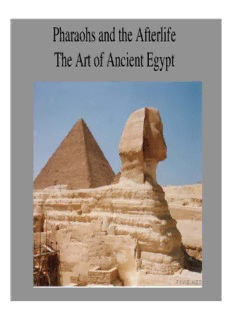
Pharaohs and the Afterlife The Art of Ancient Egypt PDF
Preview Pharaohs and the Afterlife The Art of Ancient Egypt
Pharaohs and the Afterlife The Art of Ancient Egypt Where is Egypt? Did you know Egypt was located in North Eastern Africa? Ancient Egypt Goals • Understand the evolution of Egyptian culture and its relationship to the Nile. • Recognize stylistic conventions of Egyptian art. • Describe Egyptian funerary art forms from these periods and state reasons for the development of these monuments. • Understand architectural evolution from pyramid to the tomb temple and burial monuments of the Old and Middle Kingdoms. • Understand aspects of the Amarna Period as reflected in its art. Protected by desert on the West and mountains on the East, ancient Egyptian civilization flourished in isolation on the fertile plains along the Nile river. “Egypt is the Gift of the Nile” Herodotus, Greek traveler and writer, commented on the mighty Nile River in the 5th century BCE. The Nile is the world’s longest river. It winds north from equatorial Africa to the Mediterranean Sea Egyptian Civilization Abundant food and water allowed the Egyptians to develop a complex culture. People were no longer just farmers, but had the opportunity to pursue various professions. Isolated in a protected environment, Egyptian art and culture remained constant for several thousand years. Strong belief in an afterlife encouraged the development of a variety of art forms. With the use of slave labor the Egyptians built massive structures to be used as tombs for the Pharaoh.
Description: